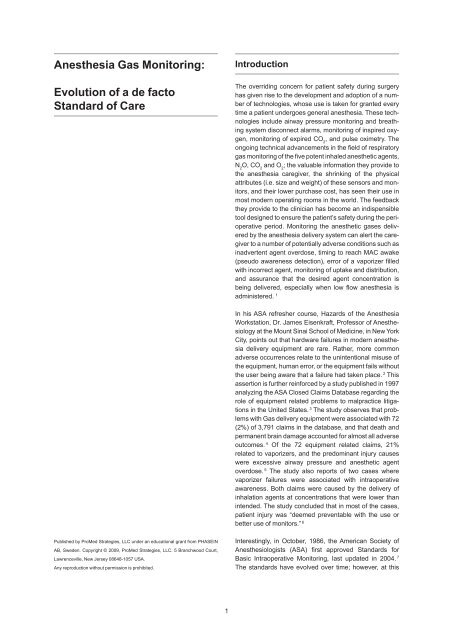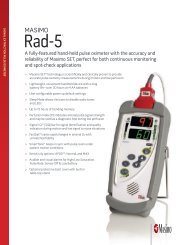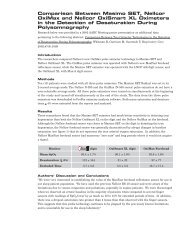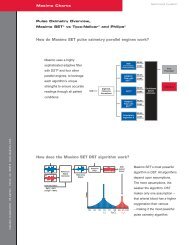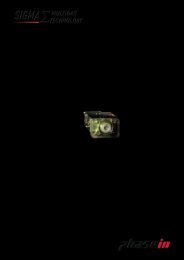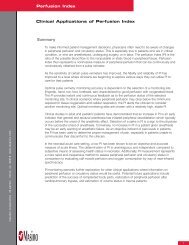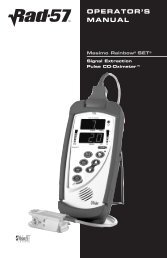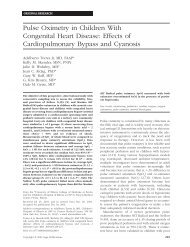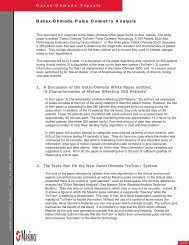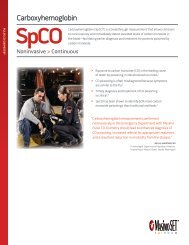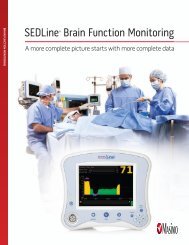Anesthesia Gas Monitoring: Evolution of a de facto ... - Masimo
Anesthesia Gas Monitoring: Evolution of a de facto ... - Masimo
Anesthesia Gas Monitoring: Evolution of a de facto ... - Masimo
You also want an ePaper? Increase the reach of your titles
YUMPU automatically turns print PDFs into web optimized ePapers that Google loves.
Stand-alone mass spectrometers, like the Ohmeda 6000,mitigated that risk and provi<strong>de</strong>d continuous, nearly instantaneous,readings instead <strong>of</strong> intermittent readings <strong>of</strong> a fewseconds (2 breaths analyzed or for 30 seconds if Stat buttonpressed) at a time obtained from a central system. Furthermore,the Ohmeda 6000 was found to be as accurateas a centralized/multiplexed mass spectrometer. 15 In addition,its adjustable flow rate <strong>of</strong> as little as 30 mL/min facilitatedits use with infants. Another advantage <strong>of</strong> the Ohmeda6000 was that it could be s<strong>of</strong>tware programmed to beused with any gas or new agent. 16The 1990s saw the emergence <strong>of</strong> a number <strong>of</strong> competing,more affordable, si<strong>de</strong>stream gas monitoring technologies,which further promoted the use <strong>of</strong> stand-alone anestheticmulti-gas monitoring in each operating room. These technologiesinclu<strong>de</strong> infrared spectrometry, RAMAN spectrometry,infrared photoacoustic spectrometry, and piezoelectriccrystal agent analysis. Agent i<strong>de</strong>ntification, eithersingly or in a mixture, a significant technological advance,was also introduced into the market by a number <strong>of</strong> manufacturers.The importance <strong>of</strong> agent specificity, or i<strong>de</strong>ntification,becomes apparent in cases where vaporizers mayhave inadvertently been misfiled, thereby creating agentmixtures. This may lead to anesthetic overdose not <strong>de</strong>tectableby agent analyzers lacking an agent i<strong>de</strong>ntificationfunction. One such example was the case where is<strong>of</strong>luranewas mistakenly ad<strong>de</strong>d to a halothane vaporizer,causing the agent analyzer to behave erratically and creatingthe initial incorrect impression that it was malfunctioning.17, 18In contemporary anesthesia practice, however, anestheticagents are routinely and intentionally exchanged in midcase.Frequently, induction is started with a rapidly acting(insoluble) agent such as <strong>de</strong>sflurane or sev<strong>of</strong>lurane; theagent is then replaced for maintenance with a less expensiveagent such as is<strong>of</strong>lurane. The safe practice <strong>of</strong> thistechnique provi<strong>de</strong>s additional rationale for the use <strong>of</strong> anesthesiagas analyzers that provi<strong>de</strong> agent i<strong>de</strong>ntification.For a variety <strong>of</strong> technical and commercial reasons, anesthesiagas analyzers based on innovative technologiessuch as Raman spectroscopy, infrared photoacousticspectrometry, and piezoelectric crystal agent analysishave not succee<strong>de</strong>d in the marketplace. Raman scattering<strong>of</strong> laser light was used to i<strong>de</strong>ntify and quantify oxygen,nitrogen, carbon dioxi<strong>de</strong>, nitrous oxi<strong>de</strong> and the potent volatileanesthetic agents. Briefly, when monochromatic lightstrikes gas molecules, most <strong>of</strong> the energy scattered isabsorbed and re‐emitted at a shifted longer wavelengthbased on the constituents gases in a mixture. 19 The measuredshifted wave spectrum, using photomultiplier tubes,quantifies and i<strong>de</strong>ntifies the gases in the mixture. Ramanspectroscopy provi<strong>de</strong>s functionality equivalent to massspectroscopy but at a much lower cost. The best knownproduct based on the Raman scattering principle was theOhmeda RASCAL II, which is no longer on the marketalthough some are still in clinical use.Infrared photoacoustic spectrometry and piezoelectriccrystal agent analysis were technically innovative but sufferedfrom certain limitations which en<strong>de</strong>d their commercialviability. The infrared photoacoustic gas bench wasmarketed as the Brüel & Kjaer 1300. Two piezoelectricbenches were introduced into the market place. The first,the Siemens GM 120 monitor, shown in Figure 4, and thesecond, <strong>de</strong>veloped by ICOR <strong>of</strong> Swe<strong>de</strong>n, was marketed inthe United States by BCI and Vital Signs Inc. Neither theinfrared photoacoustic nor the piezoelectric <strong>de</strong>vices wereagent-specific. 20 In addition, the photoacoustic <strong>de</strong>vice wassensitive to external noise and vibration, 21 and the piezoelectrictechnology exhibited a pronounced sensitivity towater vapor. 22Figure 4: Siemens Servo <strong>Gas</strong> Monitor 120Of the various competing anesthetic gas measurementtechnologies, the infrared photospectrometer, emerges asa commercial and, for the most part, technical success.There are two main reasons for this. The first is that thetechnology could be implemented at a lower cost, thusreaching a larger customer base, and second is that agenti<strong>de</strong>ntification functionality could be readily ad<strong>de</strong>d to theseanalyzers. The number <strong>of</strong> competing infrared-based productson the market since the mid 1980s has greatly proliferated,but many are no longer being marketed due toobsolescence or commercial failure.Infrared-based gas analysis products such the Puritan-Bennett/Datex 222 Anesthetic Agent Monitor, Figure 5,came on the market circa 1984. The Datex 222 was thecompany’s first generation (non-ID) infrared gas bench(Jan Ekström: personal communications). The 222 wassoon followed by the Datex Normac, Dräger’s IRINA,Andros 4600 (analyzer bench)/4700 (agent ID bench),Datex Capnomac, Nellcor 2500, Ohmeda RGM, and Criticare’sPOET II. 23Figure 5: Puritan-Bennett/Datex <strong>Anesthesia</strong> Agent Monitor 2223
Andros/LumaSense 4800 anesthesia gas analyzer (Luma-Sense, Richmond, CA): A technically novel optical configuration,utilizes an elongated sample cell, internally coatedwith reflective gold. As the sample gas flows through thetube, it is illuminated with an infrared light source. Theinfrared light is then dispersed onto an internal stationarymirror that directs the light onto an oscillating diffractiongrating. The position <strong>of</strong> the grating is enco<strong>de</strong>d and knownto the internal microcomputer. The light emerging from theoscillating grating is then reflected onto an infrared <strong>de</strong>tector.This scanning process results in a spectral curve<strong>de</strong>termined by the gases present in the mixture within thesample tube. The instantaneous position <strong>of</strong> the grating isthe curve’s location on the abscissa, and the signalreceived by the infrared <strong>de</strong>tector is the amplitu<strong>de</strong> <strong>of</strong> thespectral curve. The shape <strong>of</strong> the curve is <strong>de</strong>termined bythe relative concentrations <strong>of</strong> the gases in the sample mixture.Figure 8 is representation <strong>of</strong> the Andros 4800 opticalstructure. The gas sample flow rate is 200 mL/min. 28Artema AION anesthesia gas analyzer (Artema MedicalAB; Sundbyberg, Swe<strong>de</strong>n; now Mindray <strong>of</strong> China): Thisgas analyzer is a single-beam, eight-channel, non-dispersiveinfrared (NDIR) gas analyzer. The sensor head measuresinfrared absorbance at eight different wavelengths.To measure the absorbance <strong>of</strong> light at wavelengths rangingfrom 3.9 μm to 12 μm, a broadband infrared radiationsource is used. The light transmitted from the infraredsource is filtered using a set <strong>of</strong> narrow optical band passfilters. The individual filters are mounted in a rapidly rotatingfilter wheel that interrupts the light path. The filteredlight then passes through the measurement chamberbefore reaching the infrared <strong>de</strong>tector. The filter wheel inthis gas analyzer contains eight optical filters facilitatingaccurate analysis <strong>of</strong> all respiratory gases in any mixture.The AION gas analyzer is capable <strong>of</strong> i<strong>de</strong>ntifying anestheticagents singly or in a mixture. Figure 10 is a schematic representation<strong>of</strong> the AION optical path. The sample flow ratefor this gas analyzer is 250 mL/min. 30Figure 10: Schematic representation<strong>of</strong> Artema AION gas analyzerFigure 8: Representation <strong>of</strong> the Andros 4800 AnalyzerDräger ILCA2 infrared anesthesia gas analyzer (DrägerMedical, Lubeck, Germany): This gas analyzer is based onthe use <strong>of</strong> a pulsed infrared source and a multispectral<strong>de</strong>tector. The infrared light is reflected in four directionsafter which it passes through infrared narrow-band filters,which transmit only at a particular absorbance wavelength<strong>of</strong> the gases <strong>of</strong> interest onto a pyroelectric <strong>de</strong>tector chip,as illustrated in Figure 9. The unit also provi<strong>de</strong>s an agenti<strong>de</strong>ntification function. This measurement method is notsusceptible to cross-sensitivities from gases such as watervapor, ethanol, and acetone. The sample flow for this gasanalyzer is 200 mL/min. 29RadiationBeam Splitter ArrayInfrared FilterDetector ChipIssues common to conventionalanesthesia gas analyzersConventional anesthesia si<strong>de</strong>stream gas analyzers discussedup to this point share two functional and usabilitylimitations. The first issue is the relatively high sample flowrate (which can exceed 200 mL/min) required to achievean acceptable response time <strong>of</strong> less than 300ms. The highsample flow rate impe<strong>de</strong>s the use <strong>of</strong> these analyzers withinfants whose inspiratory and expiratory gas flow rates areclose to, or less than the analyzer’s sampling gas flow rate.So, if the patient exhales at a flow rate less than the samplingrate, then inspired gas will contaminate the sample.In addition, in instances where low-flow or closed circuit,anesthesia is used; or in special cases, such as cardiopulmonarybypass, when fresh gas flow is significantlyreduced, the possibility exists for more gas to be removedfrom the patient circuit than is ad<strong>de</strong>d to it by the anesthesia<strong>de</strong>livery system. Such circumstances, if vigilance is notmaintained, could lead to the <strong>de</strong>velopment <strong>of</strong> subatmosphericpressures in the31, 32airway.Figure 9: ILCA2 gas sensor topologyThe second issue is one <strong>of</strong> the more daunting challengesfacing the <strong>de</strong>sign <strong>of</strong> a si<strong>de</strong>stream analyzer. It is essentialthat water vapor, liquid water, and patient secretions be5
References1. The University <strong>of</strong> Kansas Medical Center Virtual Classroom, BasicPrinciples <strong>of</strong> <strong>Anesthesia</strong> Practice, lecture on perioperative monitoringhttp://74.125.47.132/search?q=cache:KZi5PBzNW1gJ:classes.kumc.edu/sah/nura833/NURA833_archive/pptfiles/perioperativemonitoring.ppt2. Eisenkraft James B., Hazards <strong>of</strong> the <strong>Anesthesia</strong> Workstation; ASARefresher Course, Vol. 33, chapter 4, 2009, American Society <strong>of</strong>Anesthesiologists, Inc., pp. 37.3. Caplan RA, Vistica MF, Posner KL, Cheney FW; Adverse AnestheticOutcomes Arising from <strong>Gas</strong> Delivery Equipment: A ClosedClaims Analysis; Anesthesiology 1997; 87:741-8.4. ibid5. ibid6. ibid7. Standards for basic anesthetic monitoring. American Society <strong>of</strong>Anesthesiologists. http://www.asahq.org/publicationsAndServices/standards/02.pdf8. WHITE DC, WARDLEY-SMITH B; THE “NARKOTEST” ANAES-THETIC GAS METER; Br. J. Anaesth.,1972; 44: 1100-11049. Lowe, Harry J.; Hagler, Karl; Clinical and Laboratory Evaluation <strong>of</strong>an Expired Anesthetic <strong>Gas</strong> Monitor (Narko-Test); Anesthesiology.34(4):378-382, April 1971.10. ibid11. Mushlin PS, et al; Inadvertent Development <strong>of</strong> SubatmosphericAirway Pressure During Cardiopulmonari Bypass; Anesthesiology,71:459-462, 198912. Ozanne GM, Young WG, Mazzei WJ, et al: Multipatient anestheticmass spectrometry, Anesthesiology 1981; 55:62‐713. Mushlin PS, et al; Inadvertent Development <strong>of</strong> SubatmosphericAirway Pressure During Cardiopulmonari Bypass; Anesthesiology,71:459-462, 198914. Able M, Eisenkraft JB; Erroneous Mass Spectrometer ReadingsCaused by Desflurane and Sev<strong>of</strong>lurane; Journal <strong>of</strong> Clinical <strong>Monitoring</strong>,1995; 11:152-15815. Schulte TG, Block FE; Evaluation <strong>of</strong> a Single-Room, DedicatedMass Spectrometer; International Journal <strong>of</strong> Clinical <strong>Monitoring</strong> andComputing; 8:179-181;199116. Ehrenwerth J, Eisenkraft JB; <strong>Anesthesia</strong> Equipement – Principlesand Applications; Mosby, 1993; pg. 210.17. Block FE, Schulte GT; Observations on use <strong>of</strong> wrong agent in ananesthesia agent vaporizer; Journal <strong>of</strong> Clinical <strong>Monitoring</strong> 15:57-61;199918. Morrison JE, McDonald C; Erroneous Data from an Infrared Anesthetic<strong>Gas</strong> Analyzer; Journal <strong>of</strong> Clinical <strong>Monitoring</strong>, 9: 293-294,199319. Ehrenwerth J, Eisenkraft JB; <strong>Anesthesia</strong> Equipement – Principlesand Applications; Mosby, 1993; pp. 213-214.20. Wal<strong>de</strong>r B, et al; Accuracy and Cross-sensitivity <strong>of</strong> 10 DifferentAnesthetic <strong>Gas</strong> Monitors; Journal <strong>of</strong> Clinical <strong>Monitoring</strong>, 9: 364-373, 1993.21. Ehrenwerth J, Eisenkraft JB; <strong>Anesthesia</strong> Equipement – Principlesand Applications; Mosby, 1993; pg. 213.22. Westenskow D, Silva F; Laboratory Evaluation <strong>of</strong> the Vital Signs(ICOR) Piezoelectric Anesthetic Analyzer; Journal <strong>of</strong> Clinical <strong>Monitoring</strong>,7: 189-194, 1991.23. Wal<strong>de</strong>r B, et al; Accuracy and Cross-sensitivity <strong>of</strong> 10 DifferentAnesthetic <strong>Gas</strong> Monitors; Journal <strong>of</strong> Clinical <strong>Monitoring</strong>, 9: 364-373, 1993.24. Stuart B; Infrared Spectroscopy: Fundamentals and Applications;John Wiley and Sons, 2004; pp. 16-18.25. Mo<strong>de</strong>l 4800 Product Manual – <strong>Anesthesia</strong> <strong>Gas</strong> Subsystem; AndrosInc; Revision E, March 2004.26. Multiple Medical <strong>Gas</strong> Monitors, Respired/Anesthetic: ECRI InstituteRecommendations; ECRI Institute Europe, published 2009.27. Datex-Ohmeda Compact Airway modules Technical ReferenceManual; Datex-Ohmeda Division,Instrumentarium Corp; June2001.28. Mo<strong>de</strong>l 4800 Product Manual – <strong>Anesthesia</strong> <strong>Gas</strong> Subsystem; AndrosInc; Revision E, March 2004.29. Schüttler J, Schwil<strong>de</strong>n H (editors); Mo<strong>de</strong>rn Anesthetics Handbook<strong>of</strong> Experimental Pharmacology, Vol 182; chapter on AdvancedTechnologies and Devices for Inhalational Anesthetic Drug Dosing;Meyer JU et al; Springer-Verlag Berlin Hei<strong>de</strong>lberg 2008.30. Artema AION Developer’s Manual; Artema Medical AB, 2000.31. Mushlin PS et al; Inadvertent Development <strong>of</strong> SubatmosphericAirway Pressure During Cardiopulmonary Bypass; Anesthesiology71: 459-462, 1989.32. Huffman LM, Riddle RT; Mass Spectrometer and/or CapnographUse During Low Flow, Closed Circuit <strong>Anesthesia</strong> Administration;Anesthesiology 66: 439-440, 1987.33. Perma Pure, LLC; “Drying Technology: Microporous vs Nafion”;http://www.permapure.com/tech-notes/key-concepts/drying-technology-microporous-vs-nafion/?ind=key-concepts.34. IRMA White Paper35. Eckerbom, Svenson, Zyzanski; EUROPEAN PATENT APPLICA-TION EP206569736. IRMA White Paper37. Nomoline White Paper10


